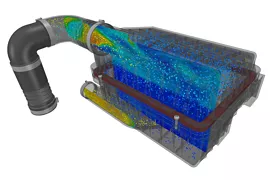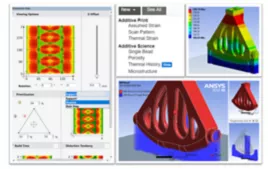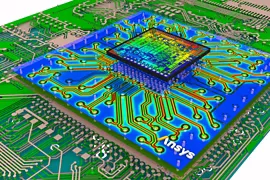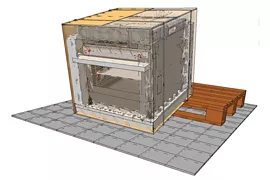Improvements in Ansys 2021 R2 products provide the power to explore early stage product design and complex system engineering from the nanometer scale of chip design to the mission level of aerospace and defense operating environments.
Ansys’ industry-leading simulation solutions provide an open approach that streamlines engineering via simplified workflows, integrated data management and easy access to high-performance computing (HPC) power via the cloud.
Engineering exploration via simulation is virtually risk free because engineers are no longer bound to an expensive and time-consuming prototype-test-redesign cycle. New design ideas can be virtually evaluated in hours, not weeks, freeing up time to optimize the best design candidates or develop moonshot ideas that redefine markets. With access to nearly limitless computing via Ansys Cloud, engineers who use Ansys 2021 R2 products have the speed and flexibility to ask the “what-if” questions that lead to innovations in autonomous vehicles, chip design, mission-critical connectivity solutions and more sustainable travel via lightweight materials and electrification.
3D Design
 Ansys 2021 R2 continues to expand simulation capabilities and ease of use for every engineer to unlock innovation and increase productivity throughout the product development process. In addition, every analyst can now benefit from Ansys Discovery’s geometry modeling workflows, groundbreaking Discovery Live physics and innovative user interface. The addition of Ansys associative CAD interfaces, history tracking and connection to Ansys Workbench makes Discovery an ideal complement to all other third-party tools and workflows within the Ansys portfolio.
Ansys 2021 R2 continues to expand simulation capabilities and ease of use for every engineer to unlock innovation and increase productivity throughout the product development process. In addition, every analyst can now benefit from Ansys Discovery’s geometry modeling workflows, groundbreaking Discovery Live physics and innovative user interface. The addition of Ansys associative CAD interfaces, history tracking and connection to Ansys Workbench makes Discovery an ideal complement to all other third-party tools and workflows within the Ansys portfolio.
Enhancements include:
- More engineering use cases: Idealized sliding contact for Live physics and porous media for high-fidelity physics, enabling fast, easy to use simulation of jointed assemblies and filtered flows.
- Ansys Workbench connectivity: Empowering analysts to do geometry preparation for simulation in Discovery, including materials selections and upfront simulation, with seamless transfer to Ansys Mechanical and Ansys Fluent.
- Connected geometry workflow: Associative CAD interfaces, history tracking and a constraint-based sketching automates Discovery’s modeling operations and provides a seamless workflow from CAD to any other Workbench-connected app.
- Workflow innovation: Saved scenes, physics condition suppression and connections to Ansys Granta Selector and Ansys Granta MI accelerate and automate the simulation workflow from setup through report generation.
Additive Manufacturing
 This release Additive Solutions enhances speed and workflows for users. Users will experience a significant improvements in accuracy across the Additive Solution products.
This release Additive Solutions enhances speed and workflows for users. Users will experience a significant improvements in accuracy across the Additive Solution products.
Ansys Additive Solutions Product Highlights for 2021R2:
- Faster solve times and improved user workflows for Additive Manufacturing users with improvements in Calibration Wizard and addition of Variable Layer Heights
- Increased accuracy and numerical consistency owing to changes to meshing defaults and improved robustness to Additive Manufacturing bond connections
- Significant speed improvements in Additive Manufacturing microstructure simulations by enabling users to apply more threads
Electronics
 Ansys 2021 R2 delivers groundbreaking technologies to address challenges in 3D IC, autonomy, 5G and electrification.
Ansys 2021 R2 delivers groundbreaking technologies to address challenges in 3D IC, autonomy, 5G and electrification.
- Ansys introduces the Electronics Desktop Student version.
- Ansys HFSS Phi Plus meshing dramatically increases speed and capacity for 3D IC packaging simulation, including wire bonds.
- Ansys HFSS SBR+ enables efficient simulation of 3D dielectrics such as automotive bumper fascia and antenna radomes.
- Ansys SI Xplorer helps PCB designers to define stack-up and optimize via transitions.
- With EMA3D Cable’s mesh subgrid, engineers can define regions in the model where the mesh cell size can be different from the rest of the model.
- Ansys Icepak’s Joule heating analysis solves coupled electrothermal problems with static or transient excitations, while thermal ROM simplifies setup for variable flow rate problems. Icepak solver improvements enable 10 to 100X faster times for MCAD geometry processing and solving.
- Ansys Maxwell A-Φ solver enhances conductive EMC analysis for busbars, power electronics and PCBs.
- Ansys Maxwell 2D skew model enables 3D simulation accuracy of electrical machines at the speed of 2D.
- Multiphysics enhancements broaden applications of NVH in electromechanical devices and improve the thermal dependency response of permanent magnets.
- Introducing Ansys Nuhertz FilterSolutions — an RF and digital filter design, synthesis and optimization solution with Ansys HFSS integration.
Webinars
Fluids
 This release delivers features for improved workflows and more advanced simulations, including:
This release delivers features for improved workflows and more advanced simulations, including:
- Accurate and efficient simulation of bulk granular flows by coupling discrete element simulations to fluids and structures with Ansys Rocky.
- Up to 5X speed ups for high-speed flows to Mach 30 and above, with improved treatment of reaction sources in the density-based solver.
- Increased accuracy for hypersonic simulations with built-in thermodynamic non-equilibrium effects, NASA-9 coefficient material properties and partial slip-wall model for rarefied flows.
- A new built-in workflow for wall recession to model surface ablation.
- Embedded best practices in the automated mesh adaption setup for combustion and multiphase applications, resulting in cell count reductions of up to 70%.
- Combustion enhancements to help push decarbonization efforts with a new strained-FGM model for better NOx and CO predictions, as well as validation of recommended hydrogen concentrations and hydrogen blends.
- More detail added in your kinetics simulations with a new framework in Ansys Chemkin-Pro that now supports a liquid phase.
Webinars
Materials
 Our 2021 R2 release significantly improves the productivity for design, simulation and materials engineers by making trusted materials data quicker and easier to access.
Our 2021 R2 release significantly improves the productivity for design, simulation and materials engineers by making trusted materials data quicker and easier to access.
Enhancements include:
- Bring materials into early-stage design with new integrations between Ansys Granta Selector, Ansys Granta MI Pro and Ansys Discovery
- Simplified management of your “gold-source” materials data by building targeted datasheets for design & simulation avoiding data duplication
- The latest material data to support industry-specific applications
- Enhanced material data in Ansys MDS to enhance simulation accuracy
- Easier access to difficult to find substances data with our new Chemwatch partnership
Webinars
Photonics
 The 2021 R2 release delivers powerful capabilities that speed time to result, improve simulation accuracy and expand interoperability with other Ansys products.
The 2021 R2 release delivers powerful capabilities that speed time to result, improve simulation accuracy and expand interoperability with other Ansys products.
- New HPC and OS support includes the availability of Ansys Cloud Direct and updated support for SUSE and Ubuntu Linux.
- Integration with Ansys OptiSLang enables users to drive multiproduct simulation workflows.
- New capabilities for Ansys Lumerical MQW include support for excitons in gain calculation, a new user interface and additions to the material database.
- Ansys Lumerical STACK now includes support for thick layers, larger than the coherence length, for emissive display applications.
- A new workflow for Lumerical STACK and Ansys SPEOS for display applications from nano pixel design to human perception analysis.
- Improvements to Lumerical System Tools: the ability for Lumerical INTERCONNECT to import netlists from Tanner S-Edit, improvements to photonic compact models in CML Compiler, and Touchstone format support for optical simulation.
- Improvements to process-enabled custom component design include new layer builder support for electrical and thermal material models in foundry process files.
- Ansys Lumerical FEEM now includes anisotropic material support and a new PML boundary condition, allowing highly accurate loss calculations of leaky waveguides and fibers.
Webinars
Platform
 In Ansys 2021 R2, the platform product collection aims to brings tighter integrations with Ansys physics solvers to provide a much enhanced end user experience.
In Ansys 2021 R2, the platform product collection aims to brings tighter integrations with Ansys physics solvers to provide a much enhanced end user experience.
Enhancements include:
- Ansys optiSLang adds flexibility and accessibility with the new packaging model that includes premium and enterprise license options. In addition, optiSLang accelerates innovation through tighter integrations with Ansys Electronics Desktop and Ansys Workbench, allowing engineers to leverage the power of optiSLang directly from the solvers.
- Ansys Minerva enhances collaboration with custom dashboards that communicate relevant information efficiently among teams and contains a host of sleek, rich UI enhancements that greatly improve engineering productivity.
- Ansys LS-DYNA and LSTC are now Ansys Cloud-enabled, and a larger portfolio of Ansys products are available directly from the desktop application for HPC batch solves or directly in browser interactive sessions.
Webinars
Structures
 In 2021 R2, Structures products continue to deliver new features that enable flexibility, robustness and efficiency. The integration of products through Ansys Workbench enables users to leverage additional technology to broaden their scope of simulation.
In 2021 R2, Structures products continue to deliver new features that enable flexibility, robustness and efficiency. The integration of products through Ansys Workbench enables users to leverage additional technology to broaden their scope of simulation.
Enhancements include:
- Ansys Sherlock integration with Ansys LS-DYNA through a single-click automated workflow in Workbench that rapidly creates meshed models for drop-test simulations in LS-DYNA, amongst other analysis types.
- Increased exposure of LS-DYNA technologies in Ansys Mechanical including Smooth Particle Hydrodynamics (SPH), Arbitrary Lagrangian Eulerian (ALE) and implicit/explicit solutions that enable workflows such as pre-stress loading and restarts for drop-test simulations.
- Streamlined multistage analysis with Ansys Mechanical offers differing cyclic symmetry sector counts in the same model, delivering tremendous time saving by reducing the model size and cutting the run time by up to 50X.
Webinars
How Can ANSYS Help My Design Workflows?
For further information about ANSYS simply complete the form below. Upon submitting the form, you will shortly be contacted by one of our account managers.
Alternatively, you can contact us on +44 (0) 161 474 6886 or info@wildeanalysis.co.uk







